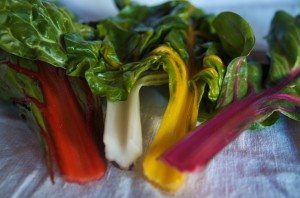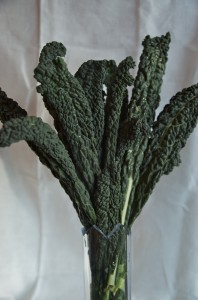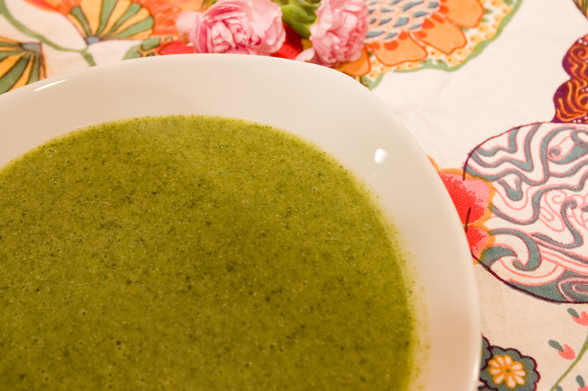Eat Your Greens!
Posted by admin | January 27, 2010 | Filed under: Ingredients
We’ve been admonished from every direction about how important it is to eat hearty greens. However, I know that the most compelling case in the world about the nutritional value of kale isn’t going to get you or your kids to touch the stuff if you aren’t pleased with its flavor.
It reminds me a bit of the way that people used to tell me how bad smoking was for me when I was a smoker. “Oh yeah? Who knew? I guess I’ll never smoke again.” Yeah, right. Who cares what the argument for the health benefits of greens is if they don’t offer a compelling, satisfying eating experience. If health benefits were enough of a reason to eat stuff, Americans would be having a dollop of cod-liver oil with their coffee every morning!
Greens are delicious and beautiful. Their flavor profiles are as varied as the differences between apples- a Fuji vs. a Granny Smith vs. a Golden Delicious. As Americans, we have this whacky notion that if something is good for you, the more you eat of it the better off you are, so you should eat a ton of it. So misguided. Throw a bunch of torn kale leaves in your soup. Add a bit of chopped fresh spinach to your quiche. Put a bit of sautéed rainbow chard over your fish. That’s all you need. Just make that a habit. Sure, you can use them as a primary side dish, but you don’t have to do that to reap the nutritional benefits of greens.
Background
Most hearty greens are members of the cabbage family, a.k.a. cruciferous veggies. Interestingly many members of this family can grow year round. We’re not talking Northern California year round. We’re talking about growing outside in the middle of a Chicago winter. Even more interestingly, the flavor of the hearty greens is improved by the cold and lack of sunlight. You see, even though plants need sunlight to survive, they can have too much of a good thing. To protect themselves against excessive exposure, the plant produces a chemical version of sunblock, the flavor of which adds further bitterness to the already pleasantly bitter profile of the leaf. As a general rule, the darker the coloration of a leaf, the more bitter it will taste- even leaves of the same plant. In the cooler, less sunny months of the year, the flavor of your greens is going to be milder and more palatable.
Another element of bitterness is the chemical weapons plants use against pests. These compounds are responsible for the antioxidants, carotenoids, and anthocyanins that are so prized for our health in the veggie family. Different plants make different amounts and kinds of these compounds, which adds to the variety of flavors found in the cabbage family.
Varieties
Cabbages: Red, White, Green, Napa, Savoy,
Kale: Red or Green Curly, Lacinato (a.k.a. Dinosaur and Tuscan), Red Russian
Spinach: Baby and mature
Asian: Tatsoi (spinach-like), Bok choy, Gai-lan
Mustard
Turnip
Beet
Collards
Chard: Swiss, Red, Rainbow
Dandelions
Selection
One of the biggest challenges with greens is their perishability. They need a bit of babying to last any length of time once they’re cut. Because of the shortened time from field to family, farmer’s market greens will be fresher and more nutritious much longer than those purchased from a grocer.
Choose greens whose stems/ribs are firm and stand upright. Avoid greens with flaccid stems and discolored leaves. Take a look at the cut end of the stem. This can be an indication of freshness. If the cut end is dried out, the leaves are likely pretty old. However, some vendors can give the ends a fresh cut before merchandising them, so this indication isn’t perfectly reliable. Also, check the leaves that are on the inside of the bunch. Some vendors will hide older or damaged leaves on the inside of a bunch.
Greens contain a lot of water. Count on about ½ a bunch per person. The leaves will reduce in size to about ¼ of their original size.
Storage
While I’m a big fan of getting refrigerated produce out of their bags, greens depend on their bags for freshness. They need restricted air flow and a cool, moist (but not wet) environment to maximize their shelf-life. The produce bag is their “happy place.”
If I know I’m going to use greens in 2-3 days, I’ll often take another route and treat them like cut flowers. They can make such a lovely, dramatic, edible display in a wide, shallow vase. They don’t last quite as long as they would in a bag in the fridge, but its fun to multipurpose them as culinary décor.
Some greens last longer than others. Kale, cabbages, bok choi and collards will last a bit longer than spinach, chard, mustards, turnips, beets or dandelions.
Preparation
As a general rule, “flat” stems are edible. Round ones are not.
Cabbages: Cut through the core to cut in half, then cut through again to make quarters. Use your knife to slice thin slivers.
Kale, collards, mustard and turnip greens: Remove the center stem by running a sharp knife along its edge. Discard the stems. Tear or chop leaves as needed.
Spinach & tatsoi: Grasp the bunch at the base. Tear off the long stems. Tear any long remaining stems individually. Bagged baby spinach doesn’t require stem removal.
Chard, beet, bok choy: Remove the leaves from the center stem/rib by running a knife along each edge of the stem. Chop the stems across their width. Cook stems until almost done before adding leaves.
Use
While sautéed greens make for a great winter side dish on a “triangle” plate (meat, starch, veg), it is a shame to limit them in this way. They offer texture, flavor and color to soups and stews. They make a delicious bed for a piece of meat that catches its juicy run-off. They are a nutritious garnish.
Collard Greens with Bacon and Garlic









